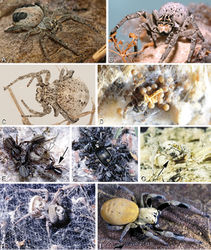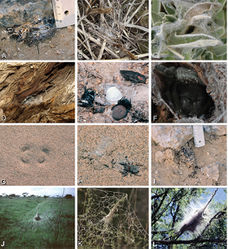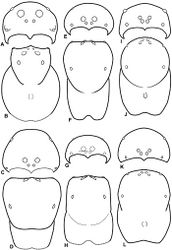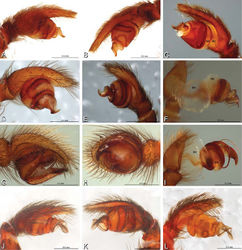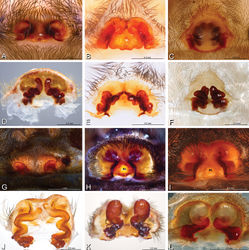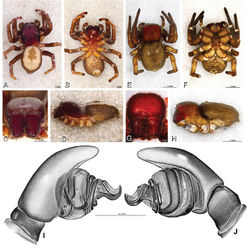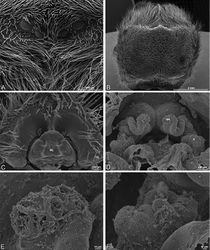Seothyra
| Notice: | This page is derived from the original publication listed below, whose author(s) should always be credited. Further contributors may edit and improve the content of this page and, consequently, need to be credited as well (see page history). Any assessment of factual correctness requires a careful review of the original article as well as of subsequent contributions.
If you are uncertain whether your planned contribution is correct or not, we suggest that you use the associated discussion page instead of editing the page directly. This page should be cited as follows (rationale):
Citation formats to copy and paste
BibTeX: @article{Miller2012ZooKeys195, RIS/ Endnote: TY - JOUR Wikipedia/ Citizendium: <ref name="Miller2012ZooKeys195">{{Citation See also the citation download page at the journal. |
Ordo: Araneae
Familia: Eresidae
Name
Seothyra Purcell – Wikispecies link – Pensoft Profile
- Seothyra Purcell 1903[1]: 31; Lehtinen 1967[2]: 264; Dippenaar-Schoeman 1990[3]: 136. Type species Seothyra schreineri Purcell, 1903.
Note
Seothyra contains 13 recognized species from southern Africa and was revised by Dippenaar-Schoeman (1990)[3]. We examined specimens of Seothyra henscheli Dippenaar-Schoeman, 1991 from Namibia. Our species identification was based on the recent revision; we did not seek to examine type material. See Dorceus for note on phylogenetic relationships.
Diagnosis
Distinguished from other eresid genera except Dorceus by the small eyes subequal in size (AME/PME > 0.7, Figs 10I, K, 72C, G), and the long, extensible ALS contrasting with reduced PLS (Fig. 72D, although ALS may be retracted and therefore not look so long). Male distinguished from Dorceus by the enlarged leg I (Figs 72A, B, 74A; legs I and II subequal in Dorceus, Fig. 26A), and by the form of the conductor, which is highly variable and elaborate and usually longer than the tegular division (Figs 15A, B, 72I, J, 73A–F; a simple spiral or L-shape hook and shorter than the tegular division in Dorceus, Figs 12D, E, 26I, J; see El-Hennawy 2002[4]). Female distinguished by the median lobe of the epigynum, which is clearly longer than wide with a central constriction (Figs 18C; 76A; wider than long with more or less straight, converging lateral margins in Dorceus, Figs 16B, 29C) and by the lack of ampullate gland spigots on the ALS (Fig. 77B).
Distinguishing species
Seothyra was revised by Dippenaar-Schoeman in 1990[3].
Natural history
Known from semi-stabilized sand dunes in semiarid desert (Dippenaar-Schoeman 1990[3]). They build a simple straight to curved 5–15 cm deep burrow (Fig. 4H). The opening is covered by two or four lobed silk flaps covered with sand, resembling a hoof print (Fig. 4G; Lubin 1989[5]; Peters 1992a[6]). Prey remnants are placed at the bottom of the burrow. The spider positions itself upside down under the burrow cover (Filmer 1995[7]). Prey are mainly ants (Dippenaar-Schoeman 1990[3]). Eggs hatch at the beginning of summer. Juveniles feed on their mother’s corpse before dispersing (cf. Fig. 3D). Mating occurs in April and May. Males are active during the day, mimicking Camponotus ants and mutillid wasps in behavior and appearance (Henschel 1989[8]).
Taxon Treatment
- Miller, J; Griswold, C; Scharff, N; Řezáč, M; Szűts, T; Marhabaie, M; 2012: The velvet spiders: an atlas of the Eresidae (Arachnida, Araneae) ZooKeys, 195: 1-144. doi
Other References
- ↑ Purcell W (1903) New Arachnida collected by Mr. S. C. Cronwright Schreiner at Hanover, Cape Colony. Annals of the South African Museum 3: 13-40.
- ↑ Lehtinen P (1967) Classification of the cribellate spiders and some allied families. Annales Zoologici Fennici 4: 199-468.
- ↑ 3.0 3.1 3.2 3.3 3.4 Dippenaar-Schoeman A (1990) A revision of the African spider genus Seothyra Purcell (Araneae: Eresidae). Cimbebasia 12: 135-160.
- ↑ El-Hennawy H (2002) Revision of the North African spider genus Dorceus C. L. Koch, 1846 (Araneida: Eresidae). Serket 8: 57-72.
- ↑ Lubin Y (1989) Namib and Negev spiders: a comparison of foraging adaptations. Bulletin of the Desert Ecological Research Unit 8: 10-12.
- ↑ Peters H (1992a) On the burrowing behaviour and the production and use of silk in Seothyra, a sand-inhabiting spider from the Namib Desert (Arachnida, Araneae, Eresidae). Verhandlungen naturwissenschaften vereins Hamburg (NF) 33: 191-211.
- ↑ Filmer M (1995) Southern African Spiders. An Identification Guide. Struik Publishers, Cape Town, 128 pp.
- ↑ Henschel J (1989) On spoons and spiders. Bulletin of the Desert Ecological Research Unit 8: 12-13.
Images
|
